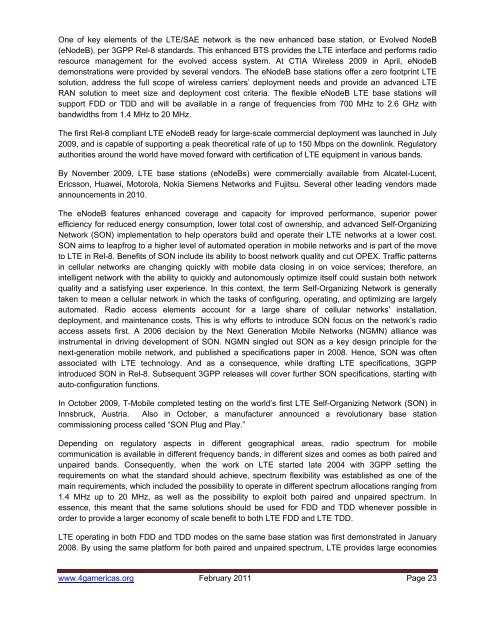Create successful ePaper yourself
Turn your PDF publications into a flip-book with our unique Google optimized e-Paper software.
One of key elements of the LTE/SAE network is the new enhanced base station, or Evolved NodeB<br />
(eNodeB), per 3GPP Rel-8 standards. This enhanced BTS provides the LTE interface and performs radio<br />
resource management for the evolved access system. At CTIA Wireless 2009 in April, eNodeB<br />
demonstrations were provided by several vendors. The eNodeB base stations offer a zero footprint LTE<br />
solution, address the full scope of wireless carriers’ deployment needs and provide an advanced LTE<br />
RAN solution to meet size and deployment cost criteria. The flexible eNodeB LTE base stations will<br />
support FDD or TDD and will be available in a range of frequencies from 700 MHz to 2.6 GHz with<br />
bandwidths from 1.4 MHz to 20 MHz.<br />
The first Rel-8 compliant LTE eNodeB ready for large-scale commercial deployment was launched in July<br />
2009, and is capable of supporting a peak theoretical rate of up to 150 Mbps on the downlink. Regulatory<br />
authorities around the world have moved forward with certification of LTE equipment in various bands.<br />
By November 2009, LTE base stations (eNodeBs) were commercially available from Alcatel-Lucent,<br />
Ericsson, Huawei, Motorola, Nokia Siemens Networks and Fujitsu. Several other leading vendors made<br />
announcements in 2010.<br />
The eNodeB features enhanced coverage and capacity for improved performance, superior power<br />
efficiency for reduced energy consumption, lower total cost of ownership, and advanced Self-Organizing<br />
Network (SON) implementation to help operators build and operate their LTE networks at a lower cost.<br />
SON aims to leapfrog to a higher level of automated operation in mobile networks and is part of the move<br />
to LTE in Rel-8. Benefits of SON include its ability to boost network quality and cut OPEX. Traffic patterns<br />
in cellular networks are changing quickly with mobile data closing in on voice services; therefore, an<br />
intelligent network with the ability to quickly and autonomously optimize itself could sustain both network<br />
quality and a satisfying user experience. In this context, the term Self-Organizing Network is generally<br />
taken to mean a cellular network in which the tasks of configuring, operating, and optimizing are largely<br />
automated. Radio access elements account for a large share of cellular networks’ installation,<br />
deployment, and maintenance costs. This is why efforts to introduce SON focus on the network’s radio<br />
access assets first. A 2006 decision by the Next Generation Mobile Networks (NGMN) alliance was<br />
instrumental in driving development of SON. NGMN singled out SON as a key design principle for the<br />
next-generation mobile network, and published a specifications paper in 2008. Hence, SON was often<br />
associated with LTE technology. And as a consequence, while drafting LTE specifications, 3GPP<br />
introduced SON in Rel-8. Subsequent 3GPP releases will cover further SON specifications, starting with<br />
auto-configuration functions.<br />
In October 2009, T-Mobile completed testing on the world’s first LTE Self-Organizing Network (SON) in<br />
Innsbruck, Austria. Also in October, a manufacturer announced a revolutionary base station<br />
commissioning process called “SON Plug and Play.”<br />
Depending on regulatory aspects in different geographical areas, radio spectrum for mobile<br />
communication is available in different frequency bands, in different sizes and comes as both paired and<br />
unpaired bands. Consequently, when the work on LTE started late 2004 with 3GPP setting the<br />
requirements on what the standard should achieve, spectrum flexibility was established as one of the<br />
main requirements, which included the possibility to operate in different spectrum allocations ranging from<br />
1.4 MHz up to 20 MHz, as well as the possibility to exploit both paired and unpaired spectrum. In<br />
essence, this meant that the same solutions should be used for FDD and TDD whenever possible in<br />
order to provide a larger economy of scale benefit to both LTE FDD and LTE TDD.<br />
LTE operating in both FDD and TDD modes on the same base station was first demonstrated in January<br />
2008. By using the same platform for both paired and unpaired spectrum, LTE provides large economies<br />
www.4gamericas.org February 2011 Page 23

















